A salmon saga
The kindness of an Alaska fisherman, old friends, a TSA garbage can billowing dry ice vapor
To the anthropologist Marcel Mauss, a gift is obligation—to receive, to reciprocate. In any gift, “obligation and liberty intermingle,” he writes.
The paper bag containing 15 pounds of flash-frozen and vacuum-packed coho and sockeye salmon filets was passed to me in the last row of the Fred Meyer parking lot in Anchorage, Alaska, five hours before my flight home to Chicago. For the next 27 hours, they took over my life.
After 10 days of reporting across the state—long drives, mountain bushwhacks, helicopter flights, boat rides and little sleep—for a National Geographic feature story about landslides (more in line with the focus of this newsletter and which I promise to get back to that in a future edition), I met a friend for a beer. An avid fisherman at the height of salmon season, he made me an offer I couldn’t refuse—free fish.
Today, if you’ll indulge me, their long, upstream migration home—which tested my problem-solving skills on 36 hours without sleep (and loaded with near-lethal doses of Dramamine to ward off seasickness the day before) and reunited two old friends.
Part 1: An American Airlines-branded cardboard box
Sunday, July 20, 3:59 p.m. (15 minutes out of the freezer in Alaska)
Frozen fish are not known to remain frozen on their own for very long. So I left the paper bag in the back seat of my rental Kia sedan and rushed into Fred Meyer, where I secured a 26-liter styrofoam cooler, a roll of packing tape and 2.5 pounds of powdered dry ice (Note: Do not attempt to “self serve” dry ice at the Anchorage Fred Meyer—you will be reprimanded). I then reconsidered at the car and returned to purchase 2.5 additional pounds of powdered dry ice, near the American Airlines legal limit of 5.5 pounds. The cashier remembered and re-entered my birthday, May 10—the same as his brother’s. “How often has that fallen on Mother’s Day?” he asked. A few times.
With 15 pounds of salmon and 5 pounds of dry ice secured in my new styrofoam cooler, I spent a few hours not thinking about the fish at all, happily working on my story in a delightful coffee shop in Spenard serenaded by a quartet of very old traditional Irish musicians. That would soon change.
Sunday, July 20, 7:44 p.m. (4 hours out of the freezer in Alaska)
I realized my mistake in line for baggage drop off at the American Airlines kiosk at Ted Stevens International Airport. In the line next to me stood a man in a flannel shirt and baseball cap towing a luggage cart stacked high with a half dozen 50-pound styrofoam-lined cardboard boxes of frozen fish, specially designed for shipping your Alaska catch home via checked luggage. The attendant took one look at my styrofoam cooler and shook her head—too big to carry on and against the rules to check without a cardboard cover. I should have purchased a fish box from Fred Meyer, she told me. Would have been great to know while I was at Fred Meyer.
She scampered off and returned with a small, American Airlines-branded cardboard box. On the luggage scale we transferred filet after filet into the box, poured in the dry ice and taped it up. I paid, she radioed ahead about “hazardous cargo” and my makeshift fish box was off down the conveyor belt, surrounded by much bigger, more official boxes. I gifted my brand-new styrofoam cooler to American Airlines and headed to my gate.
Part 2: Friends are friends, not fish. But friends do like fish, (and food).
Monday, July 21, 7:38 a.m. (15 hours, 54 minutes out of the freezer in Alaska)
It had occurred to me before I even boarded my 6.5-hour flight to Chicago that a cardboard box containing 15 pounds of salmon filets and less than 5 pounds of powdered dry ice (it had almost 6 hours to sublimate before we both got on the plane) would not remain frozen forever. I spent my time waiting for takeoff Googling dry ice sublimation rates and the insulating properties of cardboard and proper fish shipping techniques and aircraft hold temperatures. As soon as we deplaned in Chicago, very aware of the early morning 80-degree outdoor temperatures and high humidity, I asked a gate agent if I could access my checked bag. She said probably not, but to ask at baggage claim.
So, with hours before my second flight, I headed out through security to baggage claim and explained my extenuating circumstances to the attendant there, who flagged my box just in time. I yanked it off the conveyor belt and sliced it open with my house key on the tile floor—the dry ice was completely gone, but the filets were still frozen. Unfortunately, my fish and I were facing down a long layover.
You’re probably thinking, “OK, what now, smart guy?” Well, with my defrosting fish beside me in an increasingly damp cardboard box, I called up every grocery store in Rosemont and Arlington Heights until I found a Meijer that assured me it carried both dry ice and coolers. Then I snagged an Uber and rode four miles through standstill traffic. Due to a language barrier, I left him with what must have been a very confusing understanding that I was here in the Chicago suburbs on vacation from Alaska and would be staying at the Meijer in Rolling Meadows.
Monday, July 21, 9:10 a.m. (17 hours, 26 minutes out of the freezer in Alaska)
With a large duffel bag on my back, backpack on my chest and soggy cardboard box in my arms, I waddled through Meijer to the Penguin dry ice cooler and purchased an 8-pound slab of the stuff—the only size it came in. Crouching on the floor outside the self checkout, I repacked my American Airlines box with the fresh ice and re-taped. Then, tossing my precious cargo in a shopping cart, headed to the outdoor goods section and bought a rolling (carry-on size) blue Igloo cooler.
With the free fish safely (still frozen) packed into my new cooler, tags still attached, I sat down to rest on a bench in the Meijer entryway and added up my salmon-related expenses so far: $15 styrofoam cooler, $25 of powdered dry ice (sublimated), $40 bag check fee, $35 Uber, $30 of solid dry ice (new), $45 Igloo cooler. No such thing as a free fish, eh? An echoey version of “Landslide” by Fleetwood Mac started over the Meijer store speakers. I decided to make a call.
Monday, July 21, 10:24 a.m. (18 hours, 40 minutes out of the freezer in Alaska)
Christian Thorsberg—a friend from grad school, environmental journalist, photographer and (fatefully), freshly returned to the Chicago suburbs after a year working for the USGS in Alaska, showed up 20 minutes later and drove me to his parents’ house where we unloaded my cooler into their freezer and spent a delightful afternoon catching up and co-working at a cafe. After breaking up my dry ice slab into chunks (to stay under the 5.5-pound legal American Airlines limit) on the driveway with garden tools, I left him with a few filets and he drove me back to O’Hare to catch my final flight.
At this point, I think, I’d experienced the full complexity of the gift, in Mauss’ eyes. I had received my fish, with all the obligations and stresses and hidden costs. Through it, social bonds had been reinforced. And I had passed it on, continuing the chain of exchange in which, Mauss writes, “One can study the whole of human behaviour, and social life in its entirety.” I can definitely say if the fish survived frozen, I’d certainly value each filet more than ever before. At this point, they were my traveling companions. But this, I’m afraid, is not the end of the story.
An unprecedented occurrence in the O’Hare International Airport Terminal 3 TSA PreCheck line
Monday, July 21, 3:14 p.m. (23 hours, 30 minutes out of the freezer in Alaska. But, to be fair, with a few hours in the Thorsberg family freezer)
I waited in a very long line at the “special help” American Airlines desk for an attendant who was very confused by my request to check or carry on (preferably) an Igloo cooler of frozen fish and dry ice. I informed him of the American Airlines policy, which he confirmed after 10 minutes of computer searching. With my duffel bag checked and cooler as my carry on, I rolled into the TSA PreCheck line and set the fish up on the X-Ray belt. My heart sank as I watched the Igloo divert onto the belt for problematic items. Suffice to say, the fish were suspish. My duffel had done the same earlier—I’d picked up a very nice piece of anthracite atop a landslide that also required special attention. Of course, I was also pulled aside for a random pat down.
So, with 20 minutes before boarding, I found myself standing next to a stainless steel table while a man in blue latex gloves gingerly removed each frozen filet from my cooler, emanating vapor. He asked his supervisor about the TSA policy on dry ice. He’d never seen it before. She told him no one had ever attempted to take dry ice in a carry-on bag before and that it certainly wasn’t allowed. I told her that, per TSA policy, it actually was allowed. And that per American Airlines policy, the limit was 5.5 pounds. She didn’t like that, but the TSA guy asked Google AI on his iPhone if dry ice was allowed in carry-on baggage and the AI confirmed it was.
This did not assuage the supervisor’s concerns—she told me I’d have to go back out through security and double check with American Airlines on their policy. I told her I had, in fact, done that. TSA guy and I waited for ten minutes while the supervisor went out to check herself. In the meantime, we chatted about fishing (I do not fish). He was impressed with both my salmon and my cooler. (“Where did you get that Igloo?” “At the Meijer.” “In Rolling Meadows?” “Yeah.” “No way, that’s my Meijer too. I need to get one of those.”). Sympathetic, he radioed to his supervisor to ask if he could let me go. She said absolutely not—American Airlines had told her (she alleged) that dry ice was strictly prohibited.
She then returned to tell me I’d need to go back out through security and check the cooler. I told her I’d already checked another bag for $40 and really would not like to also check the cooler, and plus I’d miss my flight. She told me I could file a complaint. I asked if the dry ice was the only problem. She said yes. I looked at them both, opened the cooler, pulled out the dry ice slab, walked it to the TSA garbage can, dropped it in and rolled the cooler away, leaving the can billowing water vapor behind me.
Return to the home stream
Monday, July 21, 6:11 p.m. (26 hours, 27 minutes out of the freezer in Alaska)
I felt confident about my new Igloo cooler’s ability to keep my salmon filets frozen for an hour-long connecting flight. However, that flight was delayed as soon as I reached the gate—the flight crew was MIA. I spent the next two hours asking (embarrassingly, on two separate occasions) the nearby Starbucks for Venti cups of ice, two at a time, to pour over my frozen filets in the cooler. Then, after all that, they gate checked the thing—I frantically wrapped it up with packing tape and sent it down the conveyor belt onto the 95-degree tarmac, hoping for the best.
The cooler, a little worse for wear, was of course the very last bag to emerge on the baggage claim an hour later on the ground. Resisting the urge to open Shroedinger’s salmon cooler—allowing its contents to remain simultaneously horrendously thawed and pristinely frozen in my imagination—I drove home, with the air conditioning on full blast.
Monday, July 21, 7:24 p.m. (27 hours, 40 minutes out of the freezer in Alaska)
This is just to say
the salmon
that were in the cooler
and which
you were probably
worried about
are now safely
in the icebox
Forgive me
this newsletter will return to its regular, on-topic programming next time





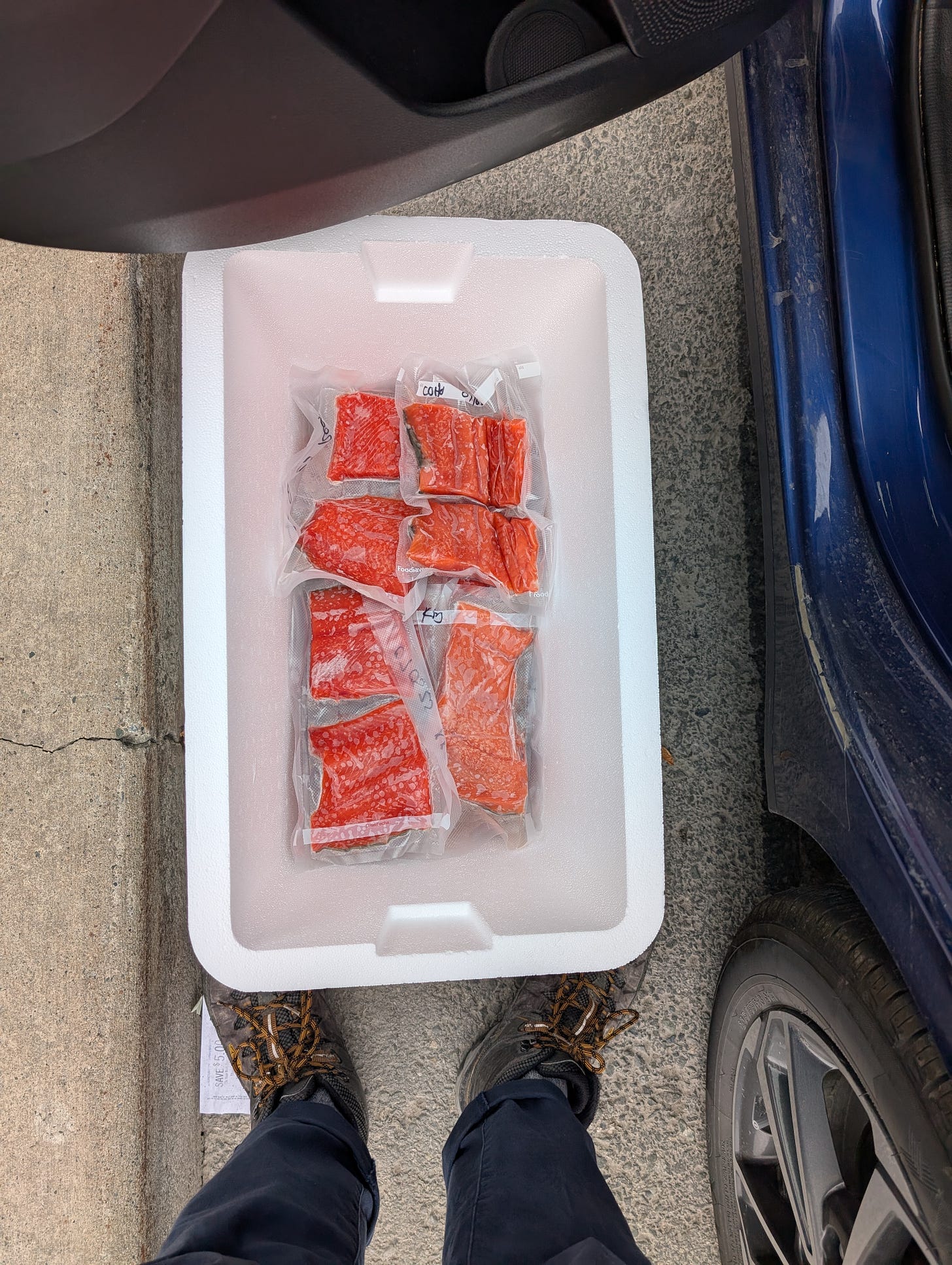
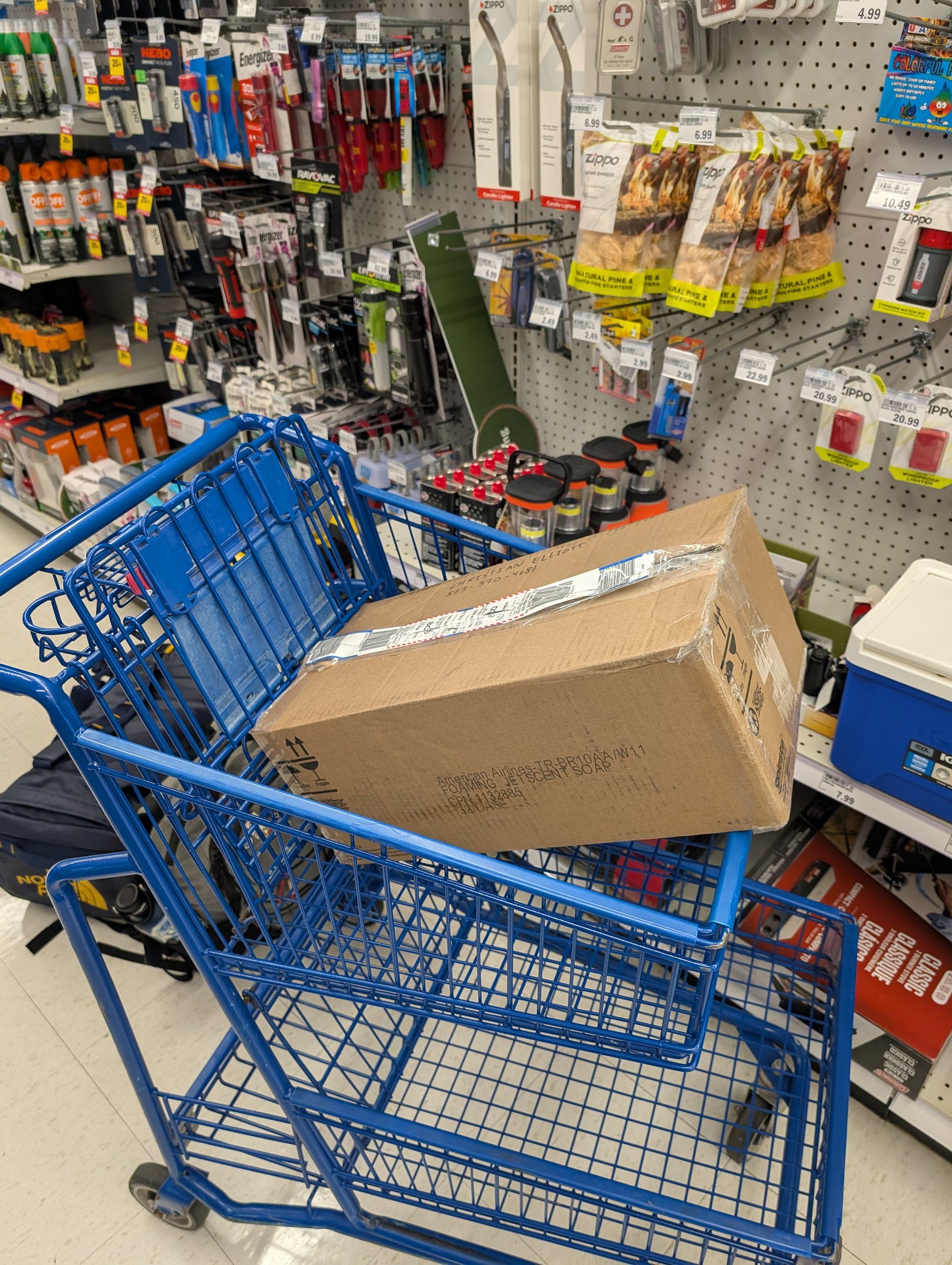
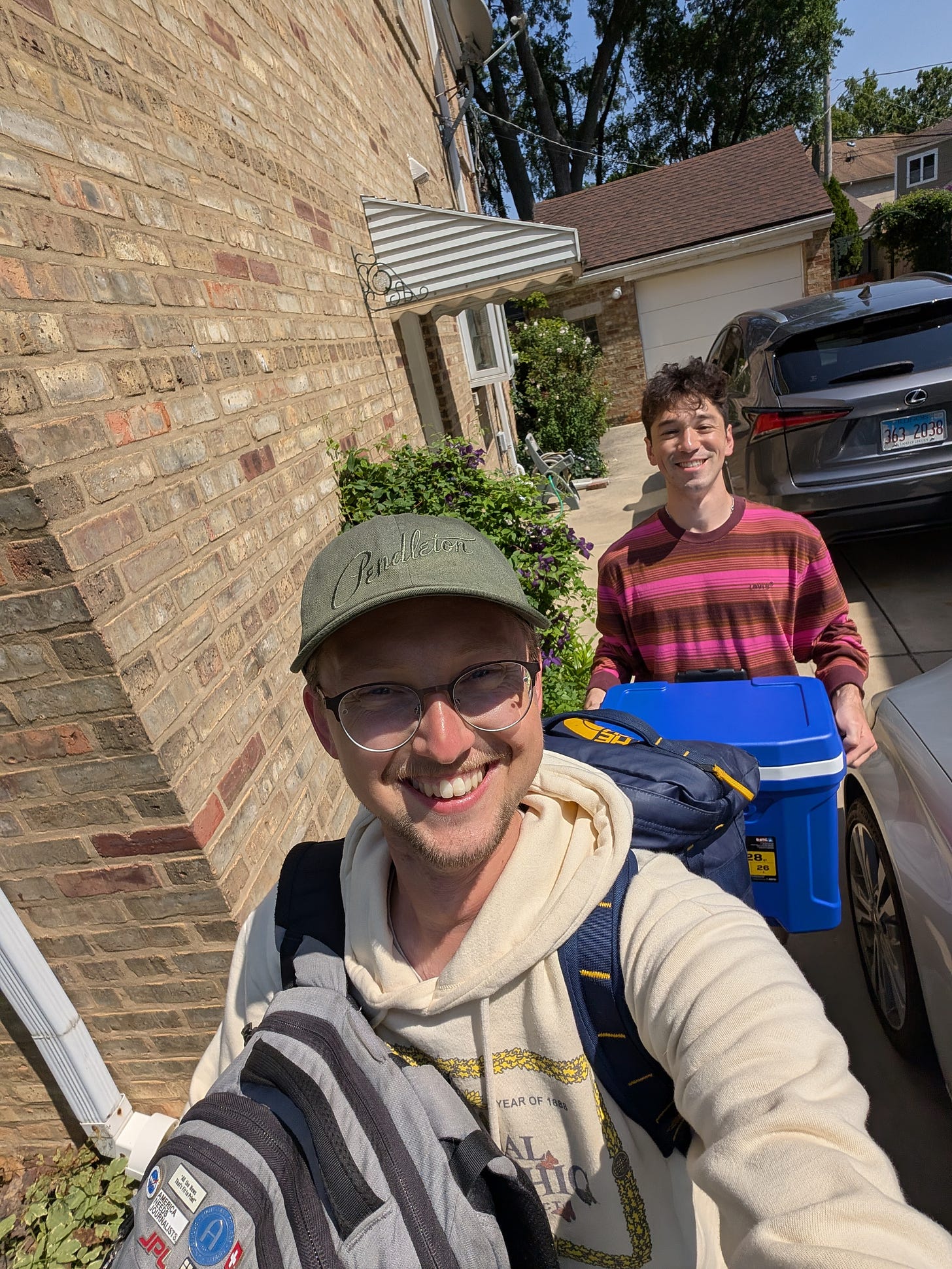
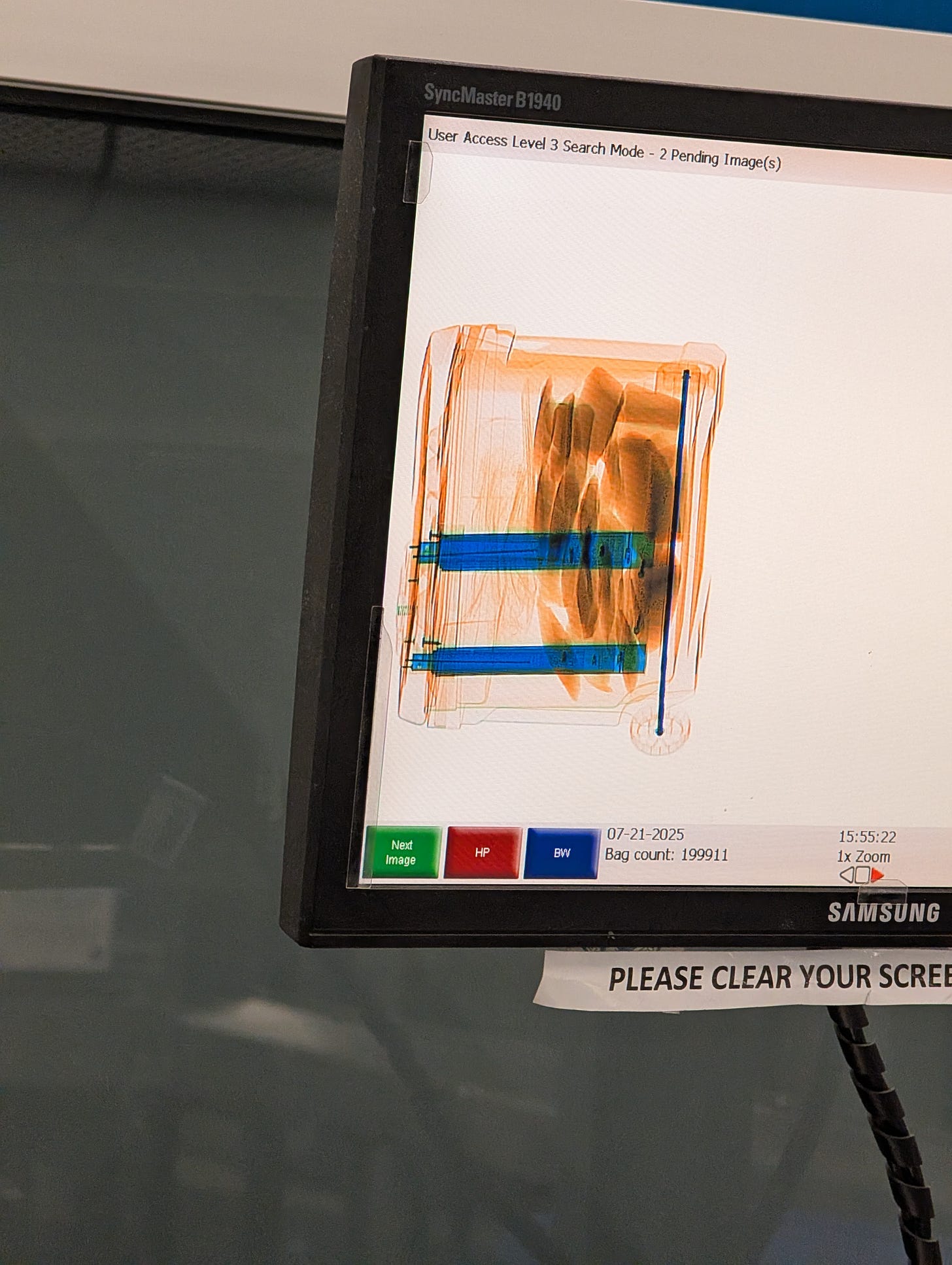
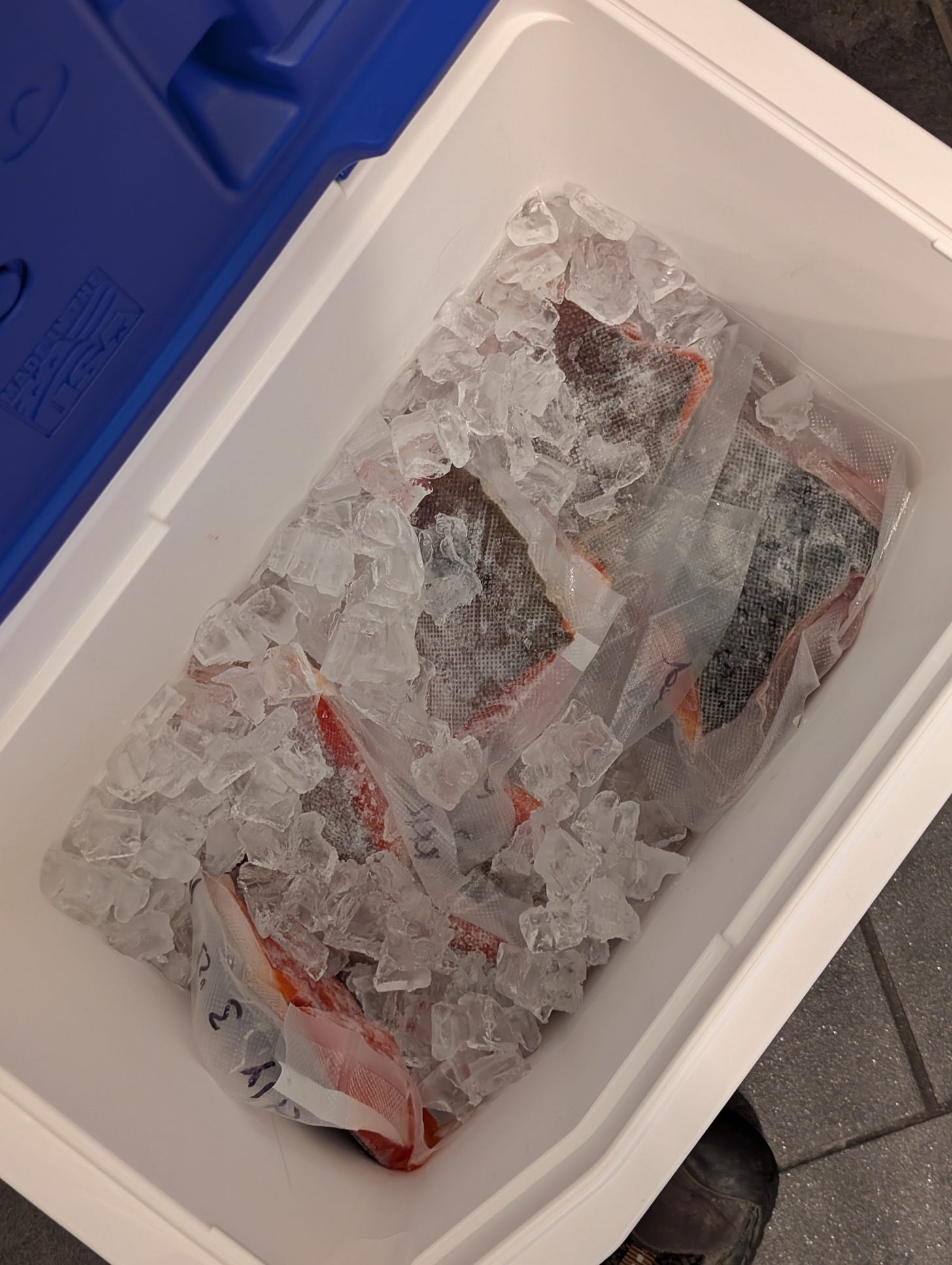
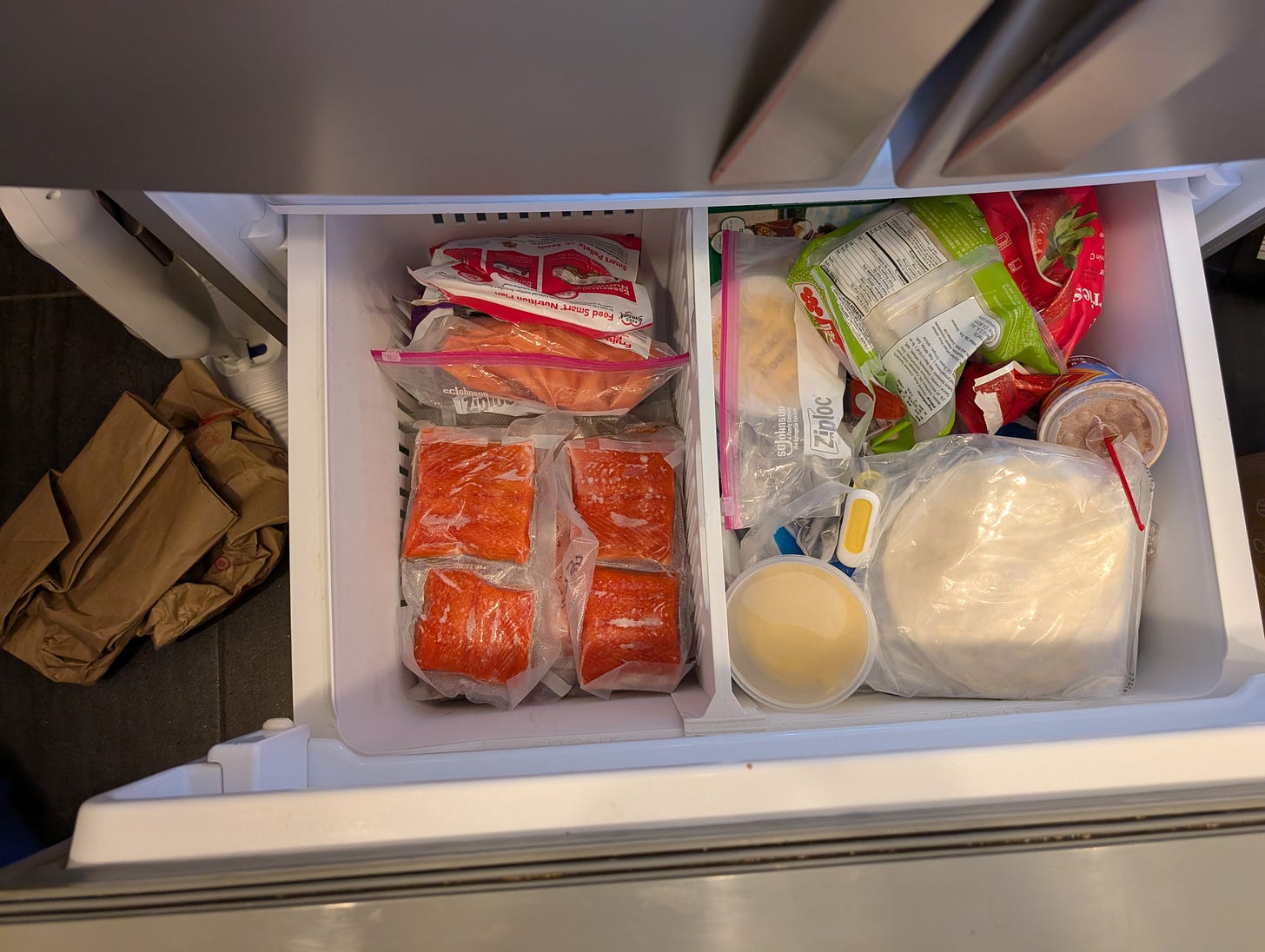
Funny how a story about salmon filets could keep one on the edge of their seat. Thanks for the chuckles!
Oh my, that was just as enjoyable in story form as it was in the frequent flurry of texts on my phone that day😆♥️